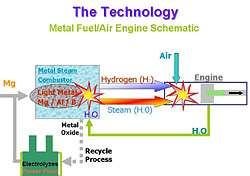The car that makes its own fuel

A unique system that can produce Hydrogen inside a car using common metals such as Magnesium and Aluminum was developed by an Israeli company. The system solves all of the obstacles associated with the manufacturing, transporting and storing of hydrogen to be used in cars. When it becomes commercial in a few years time, the system will be incorporated into cars that will cost about the same as existing conventional cars to run, and will be completely emission free.
Illustration photo – the car in this image is not related to the story. Actual pictures of Engineuity's system are classified at this stage. (Image credit: Ford)
As President Bush urges Americans to cut back on the use of oil in wake of the recent surge in prices, more and more people are looking for more viable alternatives to the use of petroleum as the main fuel for the automotive industry. IsraCast recently covered the idea developed at the Weizmann Institute to use pure Zinc to produce Hydrogen using solar power. Now, a different solution has been developed by an Israeli company called Engineuity. Amnon Yogev, one of the two founders of Engineuity, and a retired Professor of the Weizmann Institute, suggested a method for producing a continuous flow of Hydrogen and steam under full pressure inside a car. This method could also be used for producing hydrogen for fuel cells and other applications requiring hydrogen and/or steam.
The Hydrogen car Engineuity is working on will use metals such as Magnesium or Aluminum which will come in the form of a long coil. The gas tank in conventional vehicles will be replaced by a device called a Metal-Steam combustor that will separate Hydrogen out of heated water. The basic idea behind the technology is relatively simple: the tip of the metal coil is inserted into the Metal-Steam combustor together with water where it will be heated to very high temperatures. The metal atoms will bond to the Oxygen from the water, creating metal oxide. As a result, the Hydrogen molecules are free, and will be sent into the engine alongside the steam.
The solid waste product of the process, in the form of metal oxide, will later be collected in the fuel station and recycled for further use by the metal industry.
Refuelling the car based on this technology will also be remarkably simple. The vehicle will contain a mechanism for rolling the metal wire into a coil during the process of fuelling and the spent metal oxide, which was produced in the previous phase, will be collected from the car by vacuum suction.

Beside the obvious advantages of the system, such as the inexpensive and abundant fuel, the production of Hydrogen on-the-go and the zero emission engine, the system is also more efficient than other Hydrogen solutions. The main reason for this is the improved usage of heat (steam) inside the system that brings that overall performance level of the vehicle to that of a conventional car. In an interview, Professor Yogev told IsraCast that a car based on Engineuity's system will be able to travel about the same distance between refueling as an equivalent conventional car. The only minor drawback, which also limits the choice of possible metal fuel sources, is the weight of the coil. In order for the Hydrogen car to be able to travel as far as a conventional car it needs a metal coil three-times heavier than an equivalent petrol tank. Although this sound like a lot in most cars this will add up to about 100kg (220 pounds) and should not affect the performance of the car.
Engineuity is currently in the advanced stages of the incubator program of the Chief Scientist in Israel, and is seeking investors that will allow it to develop a full scale prototype. Given the proper investment the company should be able to develop the prototype in about three years. The move to Hydrogen based cars using Engineuity's technology will require only relatively minor changes from the car manufacturer's point of view. Since the modified engine can be produced using existing production lines, removing the need for investment in new infrastructures (the cost of which is estimated at billions of dollars), the new Hydrogen cars would not be more expensive. Although Engineuity's Hydrogen car will not be very different from existing conventional cars, the company is not currently planning an upgrade kit for existing cars but is concentrating on building a system that will be incorporated into new car models.
Possibly the most appealing aspect of the system is the running cost. According to Yogev, the overall running cost of the system should be equal to that of conventional cars today. Given the expected surge in oil prices in the near future Engineuity's Hydrogen car could not come too soon.
by Iddo Genuth - IsraCast
The original story can be found here.
For any comments about this story, please contact the writer of the original article.
© 2005 IsraCast. Published with permission of Iddo Genuth

















